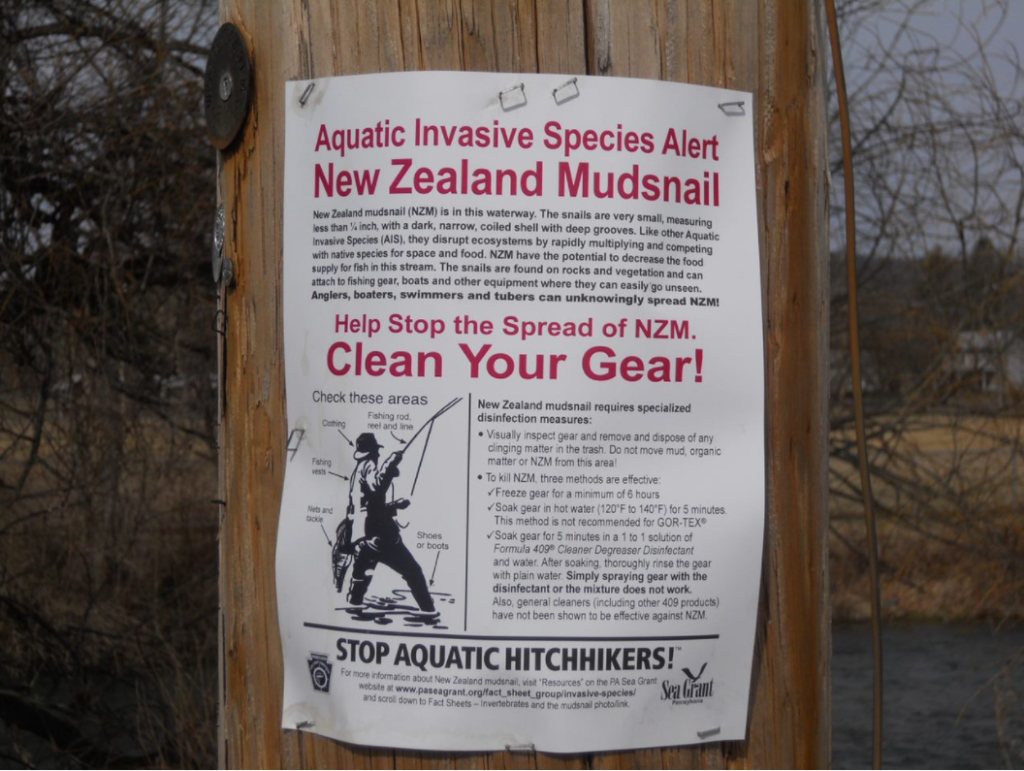Written by Amy Jewitt, Invasive Species Coordinator, Western PA Conservancy, PA Natural Heritage Program
Sourced from story featured in Spring 2021 Pennsylvania iMapInvasives Newsletter titled “My Experiences with New Zealand Mudsnails” written by Nick Macelko and Sean Hartzell
Summary: A Pennsylvania community scientist named Nick Macelko has played an important role in discovering new populations of New Zealand mudsnail, a high priority aquatic invasive species throughout the commonwealth. His experiences and data contributions to an invasive species tracking database, iMapInvasives, show the importance of being on the lookout for even the tiniest of species while also shining a light on the need for more members of the interested public to search for this and other high priority invasive species across our state.
Nick Macelko is a community scientist, someone from the general public who is interested in the natural world and being a part of purposeful efforts to learn more about and better understand it in collaboration with the work of natural resource professionals. Nick is currently a Civil Engineer in Training at PennDOT and spends his days working on projects in southeastern Pennsylvania. However, in his spare time, Nick is a passionate advocate for learning more about the many species and natural habitats that surround him locally as well as places across the state that he travels to.

Tiny New Zealand mudsnail on finger, photo by Nicholas Macelko
One such species that Nick has come to know rather well is a tiny snail, no bigger than a pencil eraser. Called the New Zealand mudsnail (NZM) (Potamopyrgus anitpodarum), this animal is aquatic in nature, typically found in springs, rivers, lakes, and estuaries. Their small size often allow NZMs to go unnoticed by many outdoor enthusiasts who might not know of their existence simply because NZMs are generally difficult to see with the naked eye.
(Fun Fact): In Pennsylvania, all populations of NZM are comprised of female clones, and even one NZM transported to a new location can spur an entirely new population there.
Nick first learned about NZMs while participating in the Pennsylvania Envirothon competition during his high school years. Later in college at Penn State University, he learned about the presence of NZMs in Spring Creek, Centre County and thought it would be feasible (and fun!) to map their locations there, which he did. Since then, Nick has surveyed other locations across the Commonwealth for the presence of NZMs, including multiple counties in SE PA. From these efforts, several new discoveries of NZM were made, including snails found in Valley Creek in Chester and Montgomery counties, and the Lehigh River in Northampton County.
NZMs are presently known from 12 counties in Pennsylvania, spanning from Erie County in the

New Zealand mudsnail Prevent the Spread Poster, photo provided by David Rebuck, PA DEP
NW, to Centre and Clinton counties in central PA, to nine counties based in SE PA. This distribution information is sourced from PA iMapInvasives, a free online resource used by land managers, academic institutions, and individuals from the interested public to document their invasive species findings and learn of species distributions from across Pennsylvania. Many of the NZM reports in iMapInvasives can be linked to observations made by Nick during his personal surveys. His reports have led to new public awareness initiatives by the PA Fish and Boat Commission and PA Sea Grant, including the hanging of “Aquatic Invasive Species Alert: New Zealand Mudsnail” posters in areas where NZMs were not previously known to occur.
In Nick’s opinion, it’s critical for more people to take part in community science efforts by searching for and sharing their findings of high priority invasive species, like NZM. In his own words, “Even if you aren’t an expert at identifying aquatic snails (or other types of species), it’s still okay to submit your report(s) to iMapInvasives by taking your best guess at what the species identification may be.”
Are you interested in following in Nick’s footsteps and participating in community science efforts? If so, visit the Pennsylvania iMapInvasives website or reach out directly to Amy Jewitt, Invasive Species Coordinator with the PA Natural Heritage Program of Western PA Conservancy at [email protected].




